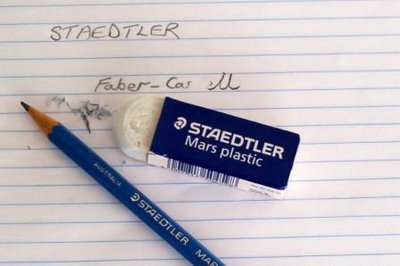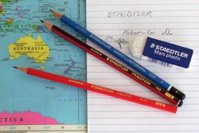Staedtler Rasoplast Eraser Review
I have previously reviewed the Staedtler Mars Plastic eraser, but Staedtler also have another similar eraser, the Rasoplast, which has been one of the mainstays of their product line for many years. So, time to put the Rasoplast to the test to see just how it differs from the Mars plastic.
Firstly then, at the risk of giving me preconceived ideas and thus skewing my results, I went to the Staedtler International website to look at these two erasers and see how Staedtler differentiate them. Well Staedtler describe these two erasers in fairly similar terms, but there are two significant differences in their website descriptions. Firstly the Mars Plastic description includes the claims “Practically residue-free erasing” and “Easy to remove eraser waste thanks to minimal crumbling”. The Rasoplast webpage makes no similar claims. The second key description difference is that the Mars Plastic is described as “Premium quality” and Rasoplast as “Comfort quality”.
Comfort quality? Comfort quality??? What the heck is that? Obviously we all like and need a bit of comfort, but what’s that got to do with erasers?
I have previously reviewed the Staedtler Mars Plastic eraser, but Staedtler also have another similar eraser, the Rasoplast, which has been one of the mainstays of their product line for many years. So, time to put the Rasoplast to the test to see just how it differs from the Mars plastic.
Firstly then, at the risk of giving me preconceived ideas and thus skewing my results, I went to the Staedtler International website to look at these two erasers and see how Staedtler differentiate them. Well Staedtler describe these two erasers in fairly similar terms, but there are two significant differences in their website descriptions. Firstly the Mars Plastic description includes the claims “Practically residue-free erasing” and “Easy to remove eraser waste thanks to minimal crumbling”. The Rasoplast webpage makes no similar claims. The second key description difference is that the Mars Plastic is described as “Premium quality” and Rasoplast as “Comfort quality”.
Comfort quality? Comfort quality??? What the heck is that? Obviously we all like and need a bit of comfort, but what’s that got to do with erasers?
 Other erasers are uncomfortable? Marketing mumbo-jumbo. I suppose maybe it’s some sort of counterpoint to the luxury brand concept? Staedtlers website is in many different languages, and I’d love to hear what the non-English sites say regarding this Premium and Comfort quality. For example, on the Italian language site, according to Google translate, the Mars Plastic is “premium quality”, but there’s no mention of the Rasoplasts quality, just that it's “improved formula”. Well there’s no mention of improved formula on the English site.
Other erasers are uncomfortable? Marketing mumbo-jumbo. I suppose maybe it’s some sort of counterpoint to the luxury brand concept? Staedtlers website is in many different languages, and I’d love to hear what the non-English sites say regarding this Premium and Comfort quality. For example, on the Italian language site, according to Google translate, the Mars Plastic is “premium quality”, but there’s no mention of the Rasoplasts quality, just that it's “improved formula”. Well there’s no mention of improved formula on the English site.The Rasoplast comes in a couple of different sizes, like the Mars Plastic. For the test I bought a 526 B20 which is the larger size, about 21mm wide x 12mm thick x 63mm long. It has a protective sleeve like the Mars Plastic. On the sleeve I note “Made In Germany”, “Latex Free” and what appear to be recycling symbols in an Asian language. Latex free – said it before and I’ll say it again, fine if you want to tell us what it isn’t made from, but at least also tell us what it is made from. I note “PP” amongst the recycling symbols. That’s got me confused because that made me think of polypropylene, and I don’t think either the eraser or the sleeve are made from PP.

 The Staedtler Mars-head logo is embossed into the surface of the Rasoplast.
The Staedtler Mars-head logo is embossed into the surface of the Rasoplast.
 The Rasoplast is definitely a harder compound than the Mars Plastic (as tested by the fingernail test method) and thus not surprisingly the Rasoplast bar is stiffer than Mars Plastic.
The Rasoplast is definitely a harder compound than the Mars Plastic (as tested by the fingernail test method) and thus not surprisingly the Rasoplast bar is stiffer than Mars Plastic.Right then, some actual eraser tests. All tests performed on ordinary photocopier paper. First up, woodcase coloured pencil. It’s very close, but a slight win to Mars Plastic.

Next woodcase HB, 4B and 6B graphite lead. Again, very close, but if I have to choose then I’d say Mars won HB and 6B, Rasoplast won 4B.

Lastly mechanical pencil lead, 0.5mm HB and 0.7mm B grade lead. No real difference.
 So, overall all then, very little difference in erasing power. As you might expect Rasoplast definitely feels harder and more abrasive in use, but it doesn’t seem to damage the paper surface. The eraser waste comes off differently, Rasoplast seems to form longer finer strings of waste and Mars Plastic definitely seems to get more graphite stains on it’s surface and thus require cleaning. Maybe Mars also tended to smear the graphite around on its first swipe a little more than Rasoplast did, but then it erased it on the second swipe. At the conclusion of the tests the amount of wear on the two erasers seemed fairly similar.
So, overall all then, very little difference in erasing power. As you might expect Rasoplast definitely feels harder and more abrasive in use, but it doesn’t seem to damage the paper surface. The eraser waste comes off differently, Rasoplast seems to form longer finer strings of waste and Mars Plastic definitely seems to get more graphite stains on it’s surface and thus require cleaning. Maybe Mars also tended to smear the graphite around on its first swipe a little more than Rasoplast did, but then it erased it on the second swipe. At the conclusion of the tests the amount of wear on the two erasers seemed fairly similar.

Final verdict – these two are quite close, but unless there was a significant economic advantage to Rasoplast, I’d stick with Mars Plastic.

 It is a reasonably large eraser which has some good and bad points. On the good side, you can get a firm grip on it which makes things easy if you have a lot of erasing to do, and you can erase an awful lot before you will need to buy a new one. So there’s slightly less need to panic during your exam when you suddenly realise you have to rub out half your wonderful design. On the bad side, whilst it starts out with nice square edges and a square end, you can’t really keep a sharp edge or fine point on this eraser so it is a bit of a blunt instrument. You definitely need an erasing shield if you have some fine erasing to do. Of course chopping the rounded end off the eraser is an option, and I have resorted to this every now and then.
It is a reasonably large eraser which has some good and bad points. On the good side, you can get a firm grip on it which makes things easy if you have a lot of erasing to do, and you can erase an awful lot before you will need to buy a new one. So there’s slightly less need to panic during your exam when you suddenly realise you have to rub out half your wonderful design. On the bad side, whilst it starts out with nice square edges and a square end, you can’t really keep a sharp edge or fine point on this eraser so it is a bit of a blunt instrument. You definitely need an erasing shield if you have some fine erasing to do. Of course chopping the rounded end off the eraser is an option, and I have resorted to this every now and then. Speaking of the compound, as you erase away, the waste does twist itself up into long strands which are easily removed, just like Staedtler claim. They also claim it is good for removing scuff marks from vinyl floors, marks from light switches and wallpaper, cleaning nail files and a whole lot of other things. I can vouch for the first few – but no idea about the nail file! The compound is relatively odourless – I recall “smelly” erasers being very popular when I was a little fellow at primary school.
Speaking of the compound, as you erase away, the waste does twist itself up into long strands which are easily removed, just like Staedtler claim. They also claim it is good for removing scuff marks from vinyl floors, marks from light switches and wallpaper, cleaning nail files and a whole lot of other things. I can vouch for the first few – but no idea about the nail file! The compound is relatively odourless – I recall “smelly” erasers being very popular when I was a little fellow at primary school.



